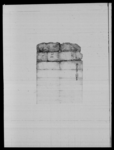A rukkā of King Gīrvāṇayuddha to the people living north of Jitpur and Sankhu re the hunting of Chukar partridge (VS 1869)
ID: DNA_0013_0070
Edited and
translated by Christof Zotter
in collaboration with
Bastian Jantke
Created: 2015-02-07;
Last modified: 2018-06-21
For the metadata of the document, click here
The accompanying edition, translation/synopsis and/or commentary are available under the terms of the Creative Commons Attribution-ShareAlike 4.0 International License
Abstract
This rukkā addressing the people living north of Jitpur and Sankhu forbids to hunt the Chukar partridge or to break its eggs and defines the respective fines.Diplomatic edition
[1r]
1[...]र्गासहाय़ः\[Royal seal]1स्वस्तिश्रीमन्महाराजाधिराजकस्यरुक्का ¯¯ ¯¯ ¯¯ ¯¯ ¯¯ ¯¯ ¯¯ ¯¯ ¯¯ ¯¯ ¯¯ ¯¯ ¯¯2आगेजीतपुरलगाइतसाँषुउत्तरजगाजगाकाअमालिथरिचारवर्नछत्ति
3सजातप्रतिजंगलमाछाड्याकाजंगलिघरकाचाषुराकसैलेनमार्नुफुलपा
4याफुलपनिनफोर्नुजसलेचाषुरामाउरवच्चामार्न्याफुलफोर्न्यालाइवमो
5जीमतपसीलकोडंडगरिडिठामार्फतदर्वारदाषीलगर्नल्याउनु ¯¯ ¯¯ ¯¯
6तपसील¯¯¯¯¯
7चाषुराकोमाउमार्न्याकेडंडरूपैया¯¯¯¯¯५०
8चाषुराकोवच्चामार्न्याकेडंडरूपैया¯¯¯¯¯२५
9चाषुराकोफुलफोर्न्याकेडंडरूपैया¯¯¯¯¯१०
10इतिसम्वत¯¯¯१८६९ सालमितिफागुनवदि६रोज१शभं¯
[1v]
1⟪(३३)⟫1⟪३७९⟫1मार्फत्रणध्वजथापाTranslation
[1r]
May venerable Durgā help [us]!
Hail. [This is] a royal order of the supreme king of great kings.1
Āge: to the āmālis, tharis, the four varṇas and the 36 jātas of the places north of [a line] from Jitpur to Sankhu.
Nobody shall kill the Chukar partridge (cākhurā) [neither that one] roaming around in the forest (jaṅgalamā chāḍyākā) nor [that one] of the forest nest (jaṅgaligharkā, lit. "of forest home") not even an egg found shall be broken. Having applied the fine according to the details to whoever kills mother and chick of the Chukar partridge or breaks an egg [the fine] shall be handed over to the palace through the ḍiṭṭhā (text: ḍiṭhā).
Details:
Fine for killing a Chukar partridge mother: 50 Rupees.
Fine for killing a Chukar partridge chick: 25 Rupees.
Fine for breaking a Chukar partridge egg: 10 Rupees.
Sunday, the 6th of the dark fortnight of Phālguna, in the [Vikrama] era year 1869 (1813 CE). Auspiciousness.
[1v]
(33)2
3783
Through (mārphat) Raṇadhvaja Thāpā
Commentary
The zoological identity of the bird spoken of in the document is not entirely clear. According to Turner 1931 (s.v. cākhuro) it is the red-legged partridge (Alectoris rufa) but more probably the chukar partridge (Alectoris chukar [Gray]) is meant here. This bird roams around in coveys or even flocks except in spring when it is breeding (cf. the dinstiction made in the document). However, as a rule, the Chukar partridge lives on open hill sides. Whistler (1949: 429) even says that "forest, however, it cannot stand."
The bird is known as "fire eater". Kirkpatrick (1811 131f.) writes: "The Chuckoar is well known to the Europeans in India by the name of the Fire-eater; it is a species of partridge, and derives its latter name from its reputed power of swallowing fire: the fact, according to the people of Nepaul, is, that in the season of love this bird is remarkably fond of red or chean-pepper; after eating two or three capsules of which, it will bite at a red-hot coal if offered to it. The Chuckoar is caught by means of a decoy of its own species surrounded by nets or spinges, into which the wild ones, who are very fierce and quarrelsome, are betrayed by their eagerness to attack the captive birds." (see also Hamilton 1819: 95).
In another rukkā, dated VS 1877 (1820 CE), King Rājendra orders to send this bird from Pokhara to Gorkha (E_1866_0006).


